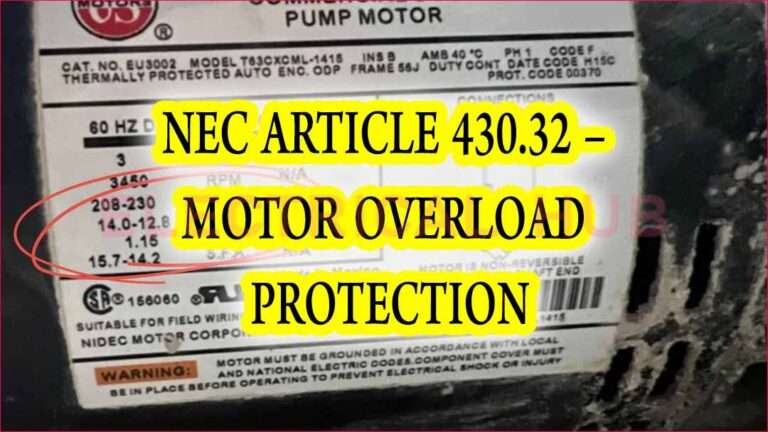Understanding the Layout of the NEC According to NEC 90.3
The National Electrical Code (NEC) is an essential guideline for the safe installation of electrical systems in buildings and other structures. The NEC is divided into various chapters, each focusing on different aspects of electrical systems and their applications. Chapter 90.3 outlines how the code is structured, with specific chapters covering general requirements, special occupancies, and communication systems. Here’s a breakdown of the layout of the NEC according to NEC 90.3.

Introduction to the NEC Layout
The NEC is divided into several chapters, each addressing specific topics. Generally, Chapters 1 to 4 apply to all electrical installations, while Chapters 5, 6, and 7 cover special occupancies, equipment, and conditions. These chapters either supplement or modify the general rules outlined in Chapters 1 through 4.
Chapter Breakdown of the NEC
Chapter 1: General Requirements
Chapter 1 of the NEC establishes the general requirements that apply throughout the entire code. This chapter is crucial because it sets the foundation for all the other chapters. However, special provisions in other chapters may modify or amend the general rules set forth in Chapter 1.
Chapter 2: Wiring and Protection
Chapter 2 focuses on wiring and protection. This chapter deals with how electrical systems are designed and protected. It is particularly important for electricians, contractors, or engineers who are designing the electrical layout for a facility. This chapter provides the guidelines for safely and efficiently designing the electrical systems of a building.
Chapter 3: Wiring Methods and Materials
Chapter 3 outlines the methods and materials used for wiring electrical systems. This chapter is typically of great importance to electricians because it specifies the materials to be used and the installation methods to ensure that the system complies with safety standards. After the plans from Chapter 2 are outlined, electricians refer to Chapter 3 to correctly install the electrical wiring.
Chapter 4: General Purpose Equipment
Chapter 4 covers general-purpose equipment used in electrical systems. This includes a wide range of equipment that does not fall under specialized categories such as hazardous locations or healthcare facilities. This chapter is essential for understanding the basic equipment that is commonly installed in most facilities.
Chapter 5: Special Occupancies and Equipment
Chapter 5 applies to special occupancies and special equipment. This chapter includes guidelines for electrical systems in specialized locations, such as healthcare facilities or hazardous locations. The provisions in Chapter 5 provide additional safety measures that are required for these types of spaces.
Chapter 6: Special Equipment
Chapter 6 addresses special equipment that does not fall under general-purpose categories or specific hazards covered in other chapters. This chapter deals with the installation of equipment that requires special considerations but can still be installed within the guidelines of Chapters 4 and 5.
Chapter 7: Special Equipment Interfaced with Other Chapters
Chapter 7 covers special equipment that interacts with other types of electrical systems. This includes Class 1, 2, and 3 circuits, emergency systems, and legally required standby systems. These specialized circuits are addressed in the 700 series of Chapter 7, and their unique installation needs are highlighted here.
Chapter 8: Communication Systems
Chapter 8 stands apart from the other chapters as it deals with communication systems. While it operates independently, it often references other chapters, especially for grounding requirements or other important systems that need to be integrated with communication setups. For example, Class 1, 2, and 3 circuits fall under the 725.3 section, which is referenced in Chapter 8.
Conclusion
In summary, the NEC is divided into a series of chapters, each of which applies to different aspects of electrical installations. Chapters 1 through 4 apply broadly, with Chapters 5, 6, and 7 addressing specific, often more complex scenarios. Chapter 8 stands alone for communication systems, though it may refer to other chapters when necessary. Understanding the structure of the NEC is essential for anyone involved in electrical design, installation, or maintenance, ensuring compliance with safety standards and regulations.
By following the guidelines in NEC 90.3, you can ensure that electrical systems are both safe and effective for their intended use. Whether you’re an electrician, contractor, or engineer, understanding this layout is vital for proper electrical installation and system integration.
#NECLayout, #NEC90_3, #ElectricalCode, #NationalElectricalCode, #ElectricalSafety, #NECStandards, #ElectricalInstallation, #NECCompliance, #ElectricalRegulations, #NECDesign, #ElectricalEngineering, #NECInterpretation, #ElectricalWork, #NECRequirements, #ElectricalProfessionals





